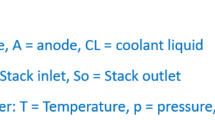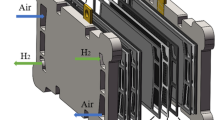Abstract
The output power efficiency of the fuel cell system mainly depends on the required current, stack temperature, air excess ratio, hydrogen excess ratio, and inlet air humidity. Therefore, the operating conditions should be optimized to get maximum output power efficiency. In this paper, a dynamic model for the fuel cell stack was developed, which is comprised of a mass flow model, a gas diffusion layer model, a membrane hydration, and a stack voltage model. Experiments have been performed to calibrate the dynamic Polymer Electrolyte Membrane Fuel Cell (PEMFC) stack model. To achieve the maximum output power and the minimum use of hydrogen in a certain power condition, optimization was carried out using Response Surface Methodology (RSM) based on the proposed PEMFC stack model. Using the developed method, optimal operating conditions can be effectively selected in order to obtain minimum hydrogen consumption.
Similar content being viewed by others
References
J. H. Bang, H. S. Kim, D. H. Lee and K. D. Min, Study on operating characteristics of fuel cell powered electric vehicle with different air feeding systems, Journal of Mechanical Science and Technology, 22 (2008) 1602–1611.
M. W. Verbrugge and R. F. Hill, Ion and solvent transport in ion-exchange membrane, J. Eletrochemical Society, 137(3) (1990) 893–899.
D. M. Bernardi and M. W. Verbrugge, A Mathematical model of the solid polymer-electrolyte fuel cell, Journal of the Electrochemical Society, 139(9) (1992) 2477–2491.
T. E. Springer, T. A. Zawodzinski and S. Gottesfeld, Polymer electrolyte fuel cell model, Journal of Electrochemical Society, 138(8) (1991) 2334–2342.
G. Sylvain, A. G. Stephanopoulos, et al., Dynamics of low-pressure and high-pressure fuel cell air supply systems, Proceedings of the American Control Conference, (2003) 2049–2054.
J. T. Pukrushpan, H. Peng and A. G. Stefanopoulou, Control-oriented modeling and analysis for automotive fuel cell Systems, Journal of Dynamic Systems, Measurement, and Control, 126(1) (2004) 14–25.
J. H. Nam and M. Kaciany, Effective diffusivity and water-saturation distribution in single-and two-layer PEMFC diffusion medium, International Journal of Heat and Mass Transfer, 46(24) (2003) 4595–4611.
D. A. Mckay, W. T. Ott and A. G. Stefanopoulou, Modeling, parameter identification, and validation of reactant and water dynamics for a fuel cell stack, Proceedings of IEMCE’05, IMECE2005-81484.
A. J. del Real, A. Arce and C. Bordons, Development and experimental validation of a PEM fuel cell dynamic model, J. of Power Sources, 173(1) (2007) 310–324.
S. K. Park and S. Y. Choe, Dynamic modeling and analysis of a 20-cell PEM fuel cell stack considering temperature and two-phase effects, J. of Power Sources, 179 (2008) 660–672.
C. Park, K. Oh, D. Kim and H. Kim, Development of fuel cell hybrid electric vehicle performance simulator, International Journal of Automotive, 5(4) (2004) 287–295.
M. J. Kim and H. Peng, Power management and design optimization of fuel cell/battery hybrid vehicles, J. of Power Sources, 165 (2007) 819–832.
G. Sikha and B. N. Popov, Performance optimization of a battery-capacitor hybrid system, J. of Power Sources. 134 (2004) 130–138.
H. H. Lin, C. H. Cheng, C. Y. Song, F. Chen and W. M. Yan, Optimization of key parameters in the proton exchange membrane fuel cell, J. of Power Sources, 162 (2006) 246–254.
G. E. P. Box and K. B. Wilson, On the experimental attainment of optimum conditions, Journal of the Royal Statistical Society, Series B, 13(1) (1951) 1–45.
W. J. Rox, N. Stander and R. T. Haftka, Response surface approximations for structural optimization, International Journal for Numerical Methods in Engineering, 42(3) (1998) 517–534.
Z. Z. Li, Y. D. Shen, H. L. Xu, J. W. Lee, K. S. Heo and S. Y. Seol, Optimal design of high temperature vacuum furnace using response surface method, Journal of Mechanical Science and Technology, 22(11) (2008) 2213–2217.
P. E. Gill, W. Murray and M. H. Wright, Practical Optimization, Academic Press, London and New York, (1981).
T. V. Nguyen and R. E. White, A water and heat management model for proton-exchange-membrane fuel cells, Journal of Electrochemical Society, 140(8) (1993) 2178–2186.
S. Dutta, S. Shimpalee and J. W. Van Zee, Numerical prediction of mass-exchange between cathode and anode channels in a PEM fuel cell, International Journal of Heat and Mass Transfer, 44 (2001) 2029–2042.
J. C. Amphlett, R. M. Baumert, R. F. Mann, et al., Performance modeling of the ballard mark IV solid polymer electrolyte fuel cell, Journal of the Electrochemical Society, 142(1) (1995) 9–15.
M. Kaviany, Principles of Heat Transfer in Porous Media, 2nd ed., Springer, (1999).
M. J. Box and N. R. Draper, Factorial designs, the |XTX| criterion and some related matters, Technometrics, 13(4) (1971) 731–742.
Author information
Authors and Affiliations
Corresponding author
Additional information
This paper was recommended for publication in revised form by Associate Editor Tong Seop Kim
Dong-Ji Xuan received his B.S. degree in Mechanical Engineering from Harbin Engineering University, China in 2000. He then received his M.S. degree in Mechanical Engineering from Chonnam National University, South Korea in 2006. Currently, he is a Ph.D. candidate of the Department of Mechanical Engineering, Chonnam National University, South Korea. His research interests include control and optimization of PEM fuel cell system, dynamics and control, and mechatronics.
Zhen-Zhe Li received his B.S. degree in Mechanical Engineering from Yanbian University, China in 2002. He then received his M.S. degree in Aerospace Engineering from Konkuk University, South Korea in 2005 and his Ph.D. degree in Mechanical Engineering from Chonnam National University, South Korea in 2009. Dr. Li is currently a Researcher of the Department of Mechanical Engineering in Chonnam National University, South Korea. Dr. Li’s research interests include applied heat transfer, fluid mechanics, and optimal design of thermal and fluid systems.
Jin-Wan Kim received his B.S. degree in Aerospace Engineering from Chosun University, South Korea in 1990. He then received his M.S. degree in Aerospace and Mechanical Engineering from Korea Aerospace University, South Korea in 2003 and his Ph.D degree in Mechanical Engineering from Chonnam National University, South Korea in 2008. He is currently a Post Doctor of the Department of Mechanical Engineering in Chonnam National University, South Korea. His research interests include control of hydraulic systems, dynamics and control, and mechatronics.
Young-Bae Kim received his B.S. degree in Mechanical Design from Seoul National University, South Korea in 1980. He then received his M.S. degree in Mechanical Engineering from the Korean Advanced Institute of Science and Technology (KAIST), South Korea in 1982 and his Ph.D. degree in Mechanical Engineering from Texas A&M University, USA in 1990. Dr. Kim is currently a Professor of the School of Mechanical and Systems Engineering in Chonnam National University, South Korea. Dr. Kim’s research interests include mechatronics, dynamics and control, and fuel cell hybrid electric vehicle (FCHEV) systems.
Rights and permissions
About this article
Cite this article
Xuan, D., Li, Z., Kim, J. et al. Optimal operating points of PEM fuel cell model with RSM. J Mech Sci Technol 23, 717–728 (2009). https://doi.org/10.1007/s12206-009-0205-y
Received:
Revised:
Accepted:
Published:
Issue Date:
DOI: https://doi.org/10.1007/s12206-009-0205-y




